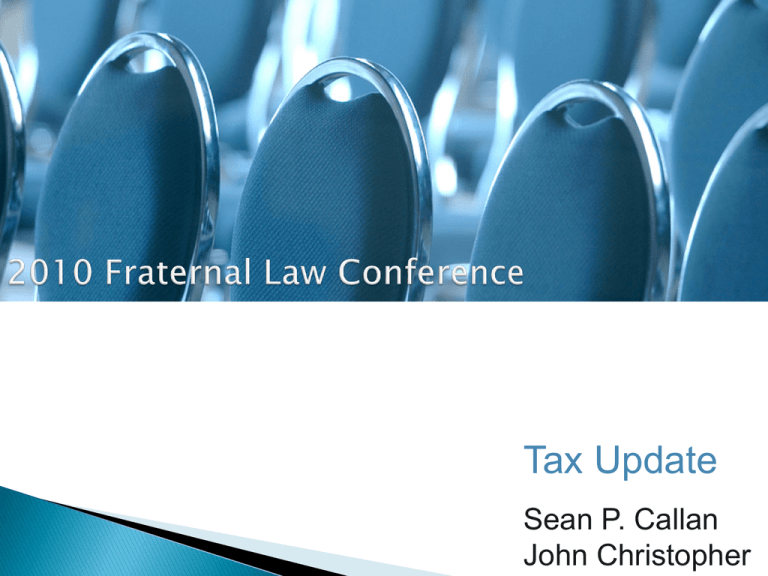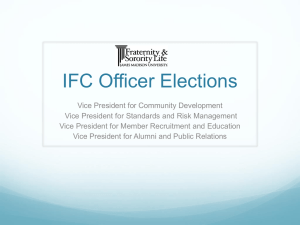2010 Fraternal Law Conference
advertisement

Tax Update Sean P. Callan John Christopher Set-asides Fraternity Foundation Grants – “The Players” Fraternity Foundation Grants – What Can be Funded? Fraternity Foundation Grants – Papering the Deal Fraternity Top 10 List What is the set aside procedure? Under the Internal Revenue Code, college fraternities and sororities pay federal income tax on their investment income of over $1,000 per year - e.g., dividends on stock, interest on bank accounts, rents, royalties, net capital gains and the like - unless such funds are set aside to be used for charitable and educational purposes. If such funds are properly set aside and used, no federal income tax is then payable. The set aside procedure should be instituted by first determining the amount of net investment income that would otherwise be subject to tax. The organization should then adopt a resolution like that below, setting aside the amount of such net investment income (or the desired amount, if less) in a separate bank account, which is identified as a "set aside fund". It is very important that this exact procedure be followed. SUGGESTED RESOLUTION At a meeting of the (governing body) of ______________ Fraternity, on the _____ day of ___________, 200__, after discussion of the net investment income for the organization's fiscal year ending __________________, 200__, the following motion was duly made, seconded, and unanimously resolved as follows: RESOLVED, that the amount of $__________ be set aside from the general assets of the __________________ Fraternity in a separate bank account to be known as set aside account no. ______ of ________________ Fraternity. RESOLVED, FURTHER, that said amount of $______________ may be used only for the following purposes: Religious, charitable, scientific, literary or educational purposes, loans on local chapter housing, or for the prevention of cruelty to children or animals; and for scholarships, student loans, leadership and citizenship schools and services, and similar purposes. _____________________________ President All amounts set aside should first be deposited in a set aside account before being disbursed for qualifying purposes. The account should clearly be labeled as set aside funds and preferably each year's set aside should also be separately designated--e.g., set aside 1-2005; set aside 2-2006, etc. It must not be commingled with an organization's general funds. While set aside funds need not be used in the same year set aside, in general, money in a set aside account should not accumulate for more than two or three years after it was set aside. Therefore, when an organization needs funds for any qualifying purpose, the amount should first be taken from set aside funds and earlier years' set aside funds should be depleted before later years. If the amount is large, it may also be invested in other ways--for example, money market or mutual fund--as long as it is properly segregated and labeled as a set aside fund. However, long term investments that are not readily available should be avoided as set aside funds are supposed to be used within a "reasonable" time. Set aside accounts cannot be loaned for general fraternal purposes. In addition, an organization may not pledge the set aside monies or otherwise use them as collateral for a third party loan. If such a transaction occurs, the set aside funds immediately become taxable. Q. Is the set aside procedure available for investment income that has been debt-financed-for example, rent received on real estate that has a mortgage on it? A. It has been the IRS' position since the set aside procedure first came into the Internal Revenue Code in 1969 that debt-financed income, such as is described in this question, would not qualify for the set aside procedure and that unrelated business income tax is due thereon under the rules of Code Section 514 relating to debt-financed income of exempt organizations generally. Q. What is the relationship between the set aside rules and the 35% test under which a fraternal organization may lose its exempt status if it receives more than 35% of its gross receipts from non-member income? A. Since investment income is by far the most common type of non-member receipts for Greek organizations, the investment income which is set aside counts towards the 35% requirement, even though it is set aside and no tax is paid thereon. It is important to note, however, that if the 35% level is exceeded, then even though tax is paid on the non-member investment income, the organization still has exposure with regard to the possible loss of its exemption--in other words, paying tax does not resolve the 35% test issue. Q. Can capital loss carryover deductions be applied against an organization's current year's investment income in determining the amount of net investment income to be set aside? A. Since the federal income tax law generally allows deductions for capital losses to offset capital gains, and allows capital losses in excess of capital gains for a particular year to be carried back three years and forward five years, it seems reasonable to conclude that capital loss carryovers are allowed as deductions from capital gains for purposes of the set aside calculation. Q. Is the set aside procedure a one time election or can it be made every year? Also, does the set aside procedure have to be used in its entirety or can a partial election be made? A. There is considerable flexibility for fraternal organizations in the use of the set aside procedure. An organization can use the set aside procedure one year and elect not to use it in the next year and so on, and vice versa. Also, the set aside procedure can be used for a specific amount of investment income and the organization can elect to pay tax on the remainder, thus freeing up such funds for general fraternal uses. Q. What can a fraternal organization do if its governing body is ready to approve the set aside resolution and the amount of investment income has not yet been computed? A. This is a scenario that is encountered quite frequently. The set aside election, in order to be effective, must be made by the date that the organization's Forms 990 and 990-T are due to be filed, including any extensions. The amount of set aside income must be computed with accuracy and should be identical on the organization's audited financial statements, tax returns and set aside resolution. Therefore, the proper method is to wait to file the election on the organization's tax return until this amount has been computed with accuracy, even if that means that an extension must be secured to file the return. In other words, filing the organization's tax return too soon with the wrong amount leaves any excess investment income subject to tax, so it is much better to postpone adoption of the resolution and the filing of the tax return until the organization is certain that the set aside amount is accurately computed. Normally – 2 Parties ◦ The Fraternity – 501(c)(7) ◦ The Foundation – 501(c)(3) Fraternity is not a charity! 1. Tax exempt? Yes, but not charitable…. 2. Member based – not formed to benefit others 3. Few limits on spending for members 4. Donations not tax deductible Foundation – charity! 1. organized and operated exclusively for religious, charitable, scientific, . . . literary, or educational purposes, 2. IRS limits spending to these purposes! 3. Donations – Tax deductible by donor Penalty for violation ◦ loss of exemption; ◦ loss of deduction by donors ◦ AG action against trustees; and ◦ IRS scrutiny of industry The Service has indicated that funding for chapter consultants, graduate consultants and similar leadership trainers can be made available by a foundation to its related fraternity, provided that the percentage of fundability is derived from time sheets kept by these persons on a contemporaneous, 40 hour per work week basis (similar to the requirement for in-office employees discussed below). When this percentage has been obtained, it may be multiplied by the overall expenses for the activity for the year in question, to obtain the fundable amount. The Service has also ruled that a foundation may fund its related fraternity's sponsored conventions, leadership conferences and similar meetings, provided that the basis for fundability is determined by a careful and reasoned analysis of the official program and other materials with respect to the conference or meeting in question. At least for large expenditures of this nature, the organization should obtain a written opinion setting forth the appropriate percentage. Also, organizations should bear in mind that workshops of this type which are 100% educational by IRS standards, although they do exist, are extremely rare; thus, if it is determined that a particular meeting does qualify for 100% funding, that decision needs to be carefully reviewed. Also, in this connection, it is important to note that a foundation may fund fraternity educational programs only on a "net" rather than "gross" basis. For example, if a fraternity sponsors a leadership conference which is 50% educational by IRS standards, the expenses are $100,000 and attendees pay $50,000 in admission fees, the maximum amount that a foundation should fund is $25,000. Also, there should be no "doubling up" as between the fraternity's set aside funds and the foundation - in other words, if the fraternity's set aside funds fully or partially fund an activity, then the Foundation cannot provide the same funding and vice versa. With regard to written materials, videos and similar publications separate and apart from meetings of the type described above, the holding in the Phi Delta Theta case, requires that such items be 100% educational in content to be funded by a foundation for its related fraternity. In other words, no allocation of the type describe above is allowed for written materials, videos and similar publications. Therefore, scholarship manuals, publications or videos concerning date rape, alcoholism, health and safety issues and similar topics are fundable but new member manuals and the like are generally not so fundable. Again, at least for large expenditures, the organization should obtain a written opinion based upon a review of the text or viewing of the item in question. A foundation may also make administrative grants to its related fraternity, based upon the Phi Gamma Delta Excerpts, for the educational and charitable percentage of the fraternity's operations, provided that such grants are based upon contemporaneously kept, written time sheets of the fraternity's employees, again on a 40 hour work week basis. These grants can cover the appropriate percentage of headquarters expenses, salaries of employees and the like. The Service has also indicated that a foundation may fund museum space and archival work of its related fraternity, provided that these items are not confined to the history of the particular fraternity alone but also cover the fraternity's relationship to educational trends, the place of women in society and similar, broader topics. Grant Proposal In writing!!! Goal oriented – not $ oriented……. Joint venture to find common ground Sufficient detail for real Board review Grant Agreement Again, in WRITING!!!! Articulate clearly the educational component of program IRS required Monitoring and claw-back provisions Impact evaluation 1. NO GRANT AGREEMENT AT ALL!!!! ◦ ◦ ◦ IRS required Must be written Benefits fraternity Assurance that it can keep $ Assurance of continued existence of foundation Requires follow-up/evaluation 2. Too many grants covered by same agreement ◦ Very common ◦ Best practice – one agreement per grant ◦ Less room for error – one on one 3. Fail to articulate educational purpose ◦ Another common error ◦ Details are perfect; no idea what purpose is ◦ IRS concern – purpose more than logistics 4. Board review and approval ◦ Very important!!! ◦ Must appear in minutes ◦ Board authorized officer must sign ◦ Keep originals for each organization 5. Recoup unused funds ◦ Monitoring and claw-back ◦ Unused fund should be returned, not carried over or applied to different grant 6. Follow-up reports ◦ Again, very important and often overlooked ◦ Value to fraternity as well ◦ Is the expenditure working? 7. Supporting Documentation ◦ Must be more than a budget and request ◦ Chapter consultants – time cards ◦ % content – how is this demonstrated? ◦ Even 100% - get program and follow-up 8. Amendments ◦ Must follow same formalities ◦ Clearly articulate relationship and need to alter relationship ◦ Why is the change needed? 9. Using Industry Terms ◦ IRS agent will review – that is the audience ◦ Avoid acronyms – TIPS ◦ Avoid trade lingo 10. Using grant agreement when you need reimbursement agreement ◦ Salaries and overhead paid to fraternity






